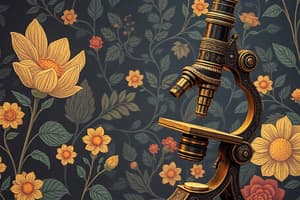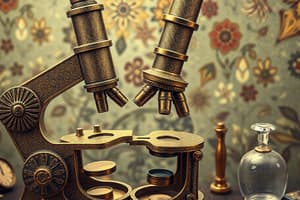Podcast
Questions and Answers
Which of the following best describes the primary function of the mechanical parts of a compound light microscope?
Which of the following best describes the primary function of the mechanical parts of a compound light microscope?
- To support, adjust, connect, and move other parts of the microscope. (correct)
- To provide light for illuminating the specimen.
- To magnify the specimen for detailed observation.
- To control the amount of light passing through the specimen.
The lenses of the first compound microscopes produced by the Janssens were simply a tube with lenses at each end. What was estimated magnification range for these early scopes?
The lenses of the first compound microscopes produced by the Janssens were simply a tube with lenses at each end. What was estimated magnification range for these early scopes?
- 5X to 15X, based on the glass clarity.
- 3X to 9X, depending on the size of the diaphragm openings. (correct)
- 10X to 20X, based on lens quality.
- 20X to 30X, depending on the tube's length.
How did Anton van Leeuwenhoek's work significantly advance the field of microscopy?
How did Anton van Leeuwenhoek's work significantly advance the field of microscopy?
- He discovered cells in cork tissue and published his findings in _Micrographia_.
- He developed a microscope with a single lens that achieved up to 300x magnification and discovered bacteria and protozoa. (correct)
- He created the first microscope with interchangeable lenses.
- He invented the first compound microscope.
In the context of using a light microscope, what is the role of the condenser, and where is it typically located?
In the context of using a light microscope, what is the role of the condenser, and where is it typically located?
What part of the microscope is primarily responsible for holding the slide in place?
What part of the microscope is primarily responsible for holding the slide in place?
Why was the pairing of lenses a useful advancement in the history of microscopes and telescopes?
Why was the pairing of lenses a useful advancement in the history of microscopes and telescopes?
Which of the following components is part of the illuminating system of a compound light microscope?
Which of the following components is part of the illuminating system of a compound light microscope?
What is the purpose of the revolving nosepiece on a microscope?
What is the purpose of the revolving nosepiece on a microscope?
If you are viewing a specimen through a microscope and need to make very precise adjustments to the focus, which knob should you use?
If you are viewing a specimen through a microscope and need to make very precise adjustments to the focus, which knob should you use?
What is the function of the arm of a microscope?
What is the function of the arm of a microscope?
Which part of the microscope directly controls the amount of light that reaches the specimen?
Which part of the microscope directly controls the amount of light that reaches the specimen?
Robert Hooke is credited with a significant contribution to cell biology. What was it?
Robert Hooke is credited with a significant contribution to cell biology. What was it?
What is the magnification of an early microscope dependent on?
What is the magnification of an early microscope dependent on?
Where would you place the specimen slide on a microscope?
Where would you place the specimen slide on a microscope?
Which part of the microscope should be used first when trying to bring a specimen into focus?
Which part of the microscope should be used first when trying to bring a specimen into focus?
Which of the following best describes the magnifying parts of a compound light microscope?
Which of the following best describes the magnifying parts of a compound light microscope?
What is the main function of a microscope?
What is the main function of a microscope?
What did Anton van Leeuwenhoek discover using his single-lens microscope?
What did Anton van Leeuwenhoek discover using his single-lens microscope?
In the context of microscopy, what does the term 'aperture' refer to?
In the context of microscopy, what does the term 'aperture' refer to?
Why are there stage clips on a microscope?
Why are there stage clips on a microscope?
Who is credited with the first creation of the microscope?
Who is credited with the first creation of the microscope?
What is the function of the light source or mirror on a microscope?
What is the function of the light source or mirror on a microscope?
What did Robert Hooke discover when he observed cork under a microscope?
What did Robert Hooke discover when he observed cork under a microscope?
Which of the following components is NOT considered part of the mechanical parts of a compound light microscope?
Which of the following components is NOT considered part of the mechanical parts of a compound light microscope?
What is the main purpose of the body tube in a microscope?
What is the main purpose of the body tube in a microscope?
Flashcards
What is a microscope?
What is a microscope?
An optical instrument using lenses to produce magnified images of small objects.
Who is Zacharias Janssen?
Who is Zacharias Janssen?
He built the first compound microscope in 1595 with his father.
What did early microscopes look like?
What did early microscopes look like?
The first compound microscopes consisted of a tube with lenses at each end.
Who is Robert Hooke?
Who is Robert Hooke?
Signup and view all the flashcards
Who is Anton van Leeuwenhoek?
Who is Anton van Leeuwenhoek?
Signup and view all the flashcards
What is the mechanical part of a microscope?
What is the mechanical part of a microscope?
Signup and view all the flashcards
What is the magnifying part of a microscope?
What is the magnifying part of a microscope?
Signup and view all the flashcards
What is the illuminating part of a microscope?
What is the illuminating part of a microscope?
Signup and view all the flashcards
What is the arm of a microscope?
What is the arm of a microscope?
Signup and view all the flashcards
What is the base of a microscope?
What is the base of a microscope?
Signup and view all the flashcards
What is the eyepiece?
What is the eyepiece?
Signup and view all the flashcards
What is the body tube?
What is the body tube?
Signup and view all the flashcards
What is the revolving nosepiece?
What is the revolving nosepiece?
Signup and view all the flashcards
What is the stage of a microscope?
What is the stage of a microscope?
Signup and view all the flashcards
What is the function of the Fine Adjustment Knob?
What is the function of the Fine Adjustment Knob?
Signup and view all the flashcards
What is the function of the Coarse Adjustment Knob?
What is the function of the Coarse Adjustment Knob?
Signup and view all the flashcards
What are stage clips for?
What are stage clips for?
Signup and view all the flashcards
What is an Iris Diaphragm?
What is an Iris Diaphragm?
Signup and view all the flashcards
What is the function of Microscope Mirror/Light Source?
What is the function of Microscope Mirror/Light Source?
Signup and view all the flashcards
What are objective lenses for?
What are objective lenses for?
Signup and view all the flashcards
What is the aperture of a microscope?
What is the aperture of a microscope?
Signup and view all the flashcards
What is a Condenser?
What is a Condenser?
Signup and view all the flashcards
Study Notes
- Understanding the parts and functions of a microscope is essential
- The goal is to identify microscope parts and focus specimens using a compound light microscope (CLM)
Short History of the Microscope
- The first microscope was built in 1595 by Hans and Zacharias Janssen in Holland
- In the 17th century it was perfected in several countries, including England by Robert Hooke, but most notably by Anton van Leeuwenhoek, a Dutchman
- The first compound microscopes made by the Janssens were a tube with lenses at each end
- These early microscopes magnified 3X to 9X, depending on the diaphragm openings
Developments in Microscope Technology
- Lenses were paired together to create compound microscopes and telescopes
- Pairing lenses increased magnification
Key Figures
- Robert Hooke (1635-1703) developed a primitive compound microscope
- In his book Micrographia (1665), Hooke coined the term "cell" to describe plant tissue, first discovering them under the microscope using cork from an oak tree
- Anton van Leeuwenhoek (1632-1723) was inspired by Hooke's Micrographia
- Leeuwenhoek used his new instrument, reaching 300x magnification with a single lens
- This was more powerful than Hooke's, enabling the discovery of microscopic things like protozoa and spermatozoa, and the microscopic structure of fleas and plant leaves
- Anton Van Leeuwenhoek was the first to see bacteria, yeast, and life in pond water
- He refined lens grinding to see living things through the microscope
Microscope Definition and Major Components
- A microscope is an optical instrument that uses lenses to produce magnified images of small objects
- A compound light microscope has three main categories: mechanical, magnifying, and illuminating
Microscope Parts and Functions
- Arm supports the tube and connects it to the base
- Base is the microscope's bottom, for support
- Eyepiece is where you look to see the specimen's image
- Body tube connects the eyepiece to the objective lenses
- Revolving Nosepiece is a part that holds multiple objective lenses that can be rotated to change power
- Stage is the platform where you place slides
- Fine Adjustment Knob is a small knob for fine-tuning specimen focus
- Coarse Adjustment Knob is a large knob for focusing
- Stage Clips hold the slide in place
- Iris Diaphragm controls light through the aperture
- Mirror/Light source is used to reflect light to the specimen
- Objective lenses increase magnification, with options like scanner, low, high, and oil immersion
- Aperture is the hole in the stage allowing light to reach the stage
- Condenser collects and focuses light from the illuminator onto the specimen, located under the stage with an iris diaphragm
Studying That Suits You
Use AI to generate personalized quizzes and flashcards to suit your learning preferences.




